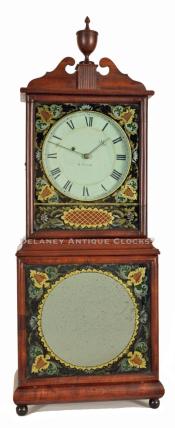A Dish Dial Massachusetts Shelf Clock made by David Wood in Newburyport. BBB-21.
The Roxbury group of clockmakers made this classic Boston case form popular. It is an empire form and is considered by many to be the last of the shelf clock forms made in quantity by artisan clockmakers. The next popular shelf clock forms were made in factories.
This cabinet is constructed in mahogany and is presented with a pleasing modern finish. The case is elevated up off the shelf by four turned wooden ball feet applied or secured to the bottom of the case. The lower section of the base section features a pillow molding of mahogany. Above this is a half-round mahogany frame. It is fitted with a period mirror. The painted decoration that frames the mirror is applied from the back. This has been fully restored and expertly executed. The theme and colors featured in the design were done to match the decoration in the upper glass. The bonnet or hood of the clock can be opened in the same manner in which a tall case clock bonnet is removed. The hood slides forward. It also has a door that is hinged on the right. This hood's nicely shaped fret pattern centers a reeded finial plinth. A turned mahogany finial in the shape of an urn is mounted atop the plinth. The bonnet door is framed in half-rounded moldings. This framing supports a reverse-painted glass tablet. This glass tablet is also an older repaint which is of excellent quality. The colors and the detailed work are outstanding. Musical string instruments, a harp version, are depicted in each of the four corners. Floral and foliage themes create the background. A gilt circle frames the open in which one views the dial.
The dial is accessed by opening the door, which is hinged on the right. Once opened, it is evident that the dial is framed with a wooden dial mask. The mask wood is pine and retains its original red paint. A circular-shaped iron dial is a convex form. It features a closed-minute ring. Roman-style hour numerals are used in each of the hour positions. A gilt circle frames the inside of the time ring. This dial is signed "D. WOOD" across the center. The hands are skillfully filed and feature the design of arrow pointers.
The time-only movement is constructed in brass and designed to run for eight days on a full wind. It is powered by a cast-iron weight and is a timepiece.
This clock was made circa 1820 and stands approximately 34.75 inches tall to the top of the finial. It is 13.25 inches wide and 5.75 inches deep.
Inventory number BBB-21.
David Wood was born the son of John Wood (1727-1805) and Eunice (Fellows) Wood (1737-1801) in Newburyport, Massachusetts, on July 5, 1766. It is thought that he may have been apprenticed to either Daniel Balch Senior or to one of the members Mulliken family. All of whom were prominent Clockmakers in this region. David advertised in the Essex Journal and New Hampshire Packet on June 13, 1792, that he had set up a shop in Market Square, near Reverend Andrews Meeting House. Three short years later, he married Elizabeth Bird (1769-1846) of Newbury in 1795. It has become evident that David Wood was also a Retailer. In 1806 he advertised that he had for sale "Willard's best Patent Timepieces, for as low as can be purchased in Roxbury." In 1818, he and Abel Moulton, a local silversmith, moved into the shop formerly occupied by Thomas H. Balch. In 1824 he advertised that he had moved on the westerly side of Market Square opposite the Market House. After his wife's death in 1846, he moved to Lexington to live near his son David, who was a merchant in that town.
It has become quite obvious to us that David Wood was a very successful Clockmaker and Retailer of Clocks. Over the last 35 years of being in the business of selling clocks, we have sold many examples of wall, shelf, and tall case clocks bearing this Maker's signature on the dial.






